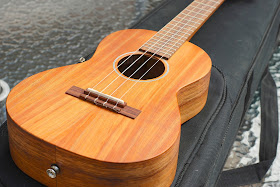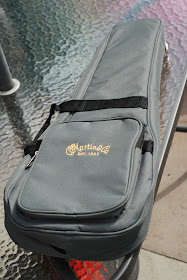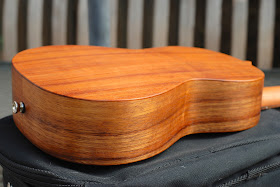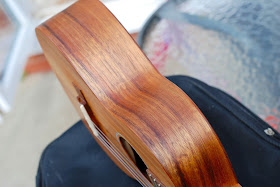As I start to write this something tells me this review may serve to create some debate or divide opinions. You see I bought myself a Martin T1K tenor ukulele recently - that is to say a NEW Martin uke, and not a uke made in Pennsylvania USA, but in Mexico - ie - one of their entry level models.
So why the debate? Well I read a lot online about the new Martin range and what I read certainly shows a division of opinion. The biggest point of debate seems to be the "are they as good as original vintage Martin" arguments. Well, at the top of this review, I thought it worth me getting my position straight. I have only ever played one vintage Martin, and that was very briefly and it was a soprano. It was lovely and all, but I write this blog mainly for beginners and like to review instruments that can be bought today. Of course, you can buy vintage Martins, but you are buying them used and a host of issues can creep in to that process. I wanted a Martin just to try one out (as despite the debates online, the consensus did seem to be positive), but don't really have any desire to buy a vintage. As such, this review will draw no comparison to older Martins, because I can't make that comparison. What it is however is a review of an instrument that anyone can buy, brand new (mine was imported from a German store - price €498). So that makes it a fairly seriously priced instrument, though way below the prices of the Hawaiian K Brands in tenor size.
As a comparison for this uke, I am writing this conscious of my review of my other Tenor - the Kanile'a K1 which costs several hundred pounds more.
 |
| The Martin T1K (note, strap button added by me!) |
The T1K is a couple of steps up from the entry level models in the Martin Ukulele range (the OXK models) and is part of their 'One' Series. To put the price above in perspective, the series runs to series five, which retail for over $5,000 dollars, so in Martin stakes, that makes this pretty cheap... It also makes their five series a daft price in my opinion, but there you go. It's made more cheaply because it is not made in the USA, but takes advantage of cheaper labour in Mexico. That isn't to say however that this makes it an equivalent of a far eastern line instrument - the Mexican factory (much as Fender and Taylor guitars do the same) is just over the border and run by Martin directly. The K in the model name sets this uke apart from the standard T1, as this is made of all solid Koa wood.
Starting with the body and overall looks, it's a standard shaped Tenor with a wider lower bout. The wood does look very nice, and the example I bought has quite a light coloured Koa. For this money don't expect any curl or flame in the wood, but I do have a nice example here I think. The top is book matched as is the back, and the grain is nicely straight on the sides. The finish is a handrubbed satin (possibly an oil finish) which means the Koa doesn't exactly shimmer but it does show some colour change when looked at from different angles, much like the Kanile'a. The construction is flawless (not a mark on it) and it feels very smooth and tactile, particularly around the edges where the top and back meet the sides. The shape feels good and it is extremely light. Looking at the back it is slightly curved to help sound projection, but nowhere near as much as my Kanile'a.
 |
| T1k bridge |
The bridge is a nice and simple tie bridge with a very low profile, finished with a compensated saddle made of Tusq (bone substitute). The bridge is specced as being either Morado or Rosewood - I think this is the latter and it is very nicely applied and finished.
 |
| Nice stripe on the sides |
The soundhole is finished with black/white/black simple circle which sets the otherwise bling free ukulele off nicely.
Looking inside the uke more closely and I note something very clearly. I am not normally a soundhole sniffer, but boy oh boy - this ukulele smells good. Full on woodshop smell! In fact, it is so strong I can smell the ukulele when I play it! The kerfling inside is nicely applied and notched, with no glue spots, and the bracing looks fairly standard and also nicely finished. The inside is finished with a Martin label and serial number, (also making it clear it is made in Mexico!)
 |
| soundhole and Martin label |
Moving on to the neck, we have a single piece of wood (nice to see), specced as being of a 'select hardwood' (search me!), and is also satin finished. The 20 nickel frets (14 to the body) are set in to a morado fingerboard which has a delightful stripe in it which I think looks great. The edges of the fingerboard are not bound so you see the fret ends, but each one is set and finished perfectly without a single rough fret edge. Fret markers are provided on the fifth, seventh, tenth, twelfth and fifteenth as well as on the side of the neck. But please please - why are they so small? I personally don't mind if ukes have the fretboard markers at all (though I do insist on side markers), but these fretboard markers are so tiny I think they look a bit silly. Martin say they are made of white ABS, but to be honest I wouldn't have a clue what they were as they are so small.
 |
| Lovely stripe, silly fret markers |
Another interesting note about the neck - Martin do not employ a standard joint between neck and body rather a dovetail arrangement. Basically, the body is finished then a dovetail channel cut out of the top into which the corresponding joint piece cut on to the heel of the neck is slotted. It certainly makes for a clean joint with no gaps whatsoever.
Up to the Tusq nut and we have a 1 and 11/32 inch width nut (significantly narrower than the Kanile'a, but then, the Kanile'a is noted to be wide at the nut). The slots are cut well and are not too deep which is good to see.
 |
| Headstock |
The headboard employs a traditional Martin shape (though a little exaggerated to my eyes perhaps) and is faced in Koa wood. The tuners are the same excellent open geared Grover models as found on the Kanile'a K1, but finished with cream plastic buttons not metal. These are excellent tuners. And then there is the logo... really not sure what Martin were thinking of here, but the logo is a raised gold sticker stuck on to the headstock. It reminds me of those gold stickers that kids use to make their own greetings cards that say 'Happy Birthday' or 'Seasons Greetings'. To me it looks cheap, nasty and totally out of place. I appreciate that costs are cut on this model, but surely a screen print would have been just as cheap. I mean, I am not expecting detailed abalone inlay, but this is just kitschy. Yuk.
 |
| Grover tuners - quality |
The whole package is finished off with some Martin flouro tenor strings and a Martin branded gig bag. A few words about the bag. As gig bags go, this is about the best quality I have yet seen - it's made by TKL. The material is thick, the logo is stitched, the zips are sturdy and everything about it screams quality. Inside the finish is plush and it even has a neck strap to keep the uke steady. All good stuff, however.... surely if you are spending this much money on a ukulele, made of beautiful solid koa wood, you really are going to then invest (like I did) in a solid case, or at least a pod case? As such I find the gig bag a little confusing. Sure it's very nice, but for me, if they are on a cost cutting drive I would have been in no way offended not to receive a bag, and for them to spend the money on a better headstock logo, on binding the edge of the fretboard or better fret markers, though perhaps that is just me.
 |
| The gig bag - not convinced. |
So on to the proper test and playing the thing. As I say it is comfortable and light and also nicely balanced. Initial play of the uke tells me that the setup is pretty darn reasonable, though the action at the saddle a touch high. I remedied that very by removing the saddle (no easy feat - dang Martin, it's almost as if you glue these in) and it's now perfect for me. Action at the nut is spot on and needed no tinkering. Tuning is helped by the wonderful Grovers, and intonation all over the neck is pretty much perfect. In fact the harmonic chimes I can get on this at the 12th fret beat any other uke I own, though perhaps that is down to loudness - more on that below.
 |
| Slightly arched back |
So my first strum in anger and.... blimey.. this is a LOUD ukulele - extremely bright and powerfully loud. I always thought Koalohas were the seriously loud ukes out there, but with the Martin strings this matches them. In fact I took this to our local group practice session, and some players said they could hear nothing else! That loudness is good news in my book up to a point, but was not totally happy with the brightness of the tone. Some claim Koa is naturally bright, but I would ask those to play a Kanile'a K1 which is earthy and woody in tone - this Martin could not be more different to the K1, with a tone bordering on a soprano tone at times. I wasn't too concerned as with all my instruments I then experiment with strings to find the right match. Sorry Martin, but whilst I like your flouro strings, I don't like them on this, and four brand changes later I have settled on Fremont Blackline flouros which have toned the brightness down, kept the best of the volume and just rounded the sound of all over. I love it now.
That volume does not come at the expense of a muddy sound however and the strings are crystal clear and evenly matched. It doesn't quite have the richness of the Kanile'a but then not only is that instrument much more expensive, but it naturally has a very different voice so it is hard to compare. I have heard better sounding ukes, but not many - and this really does have a great tone. The Martin has good sustain, but more bite and attack to the sound. If I am pushed I would say this uke suits picking more than strumming, but honestly, strumming is an absolute hoot on it on account of that volume.
In terms of living with it, that satin finish is extremely thin, and much like the Kanile'a shows finger scratches and dings with ease. After a first proper jam with friends I have already marked it and the slightest of knocks on the table dinged the butt. I personally don't mind these things, as they show the uke has been loved and played, but if you have an aversion to ukes that show marks, you may be frustrated. (I don't mean that as a criticism - as I say, I don't mind knocks - I just know that some do). I suppose it is also a rather plain looking ukulele, but regular readers of Got A Ukulele will know that I don't go in for that much bling myself, so it suits me fine.
In summary I am really rather pleased with it. It has a wonderful sound, and provides me with a nice alternative to the woody Kanile'a when I want more bight or volume. There are some niggles with the finish and detailing, but I suppose it's a price you pay for a cheaper end factory uke (though in my book, the higher end Martin prices are just plain crazy). Perhaps a vintage would be even better - who knows - but that is not what this review is about!
SCORES
Looks - 8.5
Fit and Finish - 9.5
Sound - 9
Value for money - 8.5
OVERALL - 8.9
VIDEO
© Barry Maz


I would be interested in more commentary from you on why have no interest in a vintage Martin. It would seem that your natural curiosity would cause you to have some interest in making that comparison. In my case, for instance, my first Martin purchase was a new concert model bought in 1961, followed by a new Martin soprano bought in the 1970s. A bit later in the 1970s, I bought a vintage Martin 5-K for the then going price of about $250, but found that, as a player, I actually preferred my much newer Martin concert. Still later, I bought a vintage (seems to be about mid-1930s) tenor which is still my favorite tenor of those I own, and which has been recently modified by a professional luthier with Waverly tuners (with the original vintage friction tuners bagged and placed in the case pocket). Later, I bought a vintage Martin baritone uke (probably 1960s) which I liked, but eventually found a Gibson baritone uke that I like considerably better (and still play regularly), and traded the Martin bari on the purchase of a vintage Martin 0-17 guitar built in the year of my birth. In addition, I have two vintage Martin 4-string guitars (a small bodied tenor and a plectrum) which I string with Worth baritone uke strings for a deep, mellow sound that I enjoy. I have played a few of the new entry level Martin sopranos (made in Mexico) and find them very playable and nice sounding instruments, but probably not the equivalent of my Nazareth-built Martin soprano bought new in the 1970s, which is by far my favorite soprano uke that I own. Of course, the latter instrument would likely be considered vintage by many of today's younger players. In conclusion, I hope you will post more of your thought process in saying you have no interest in acquiring a vintage Martin uke. BTW, I agree with your assessment of the prices for some of the newer Nazareth-made Martin ukes: Out of sight for most of us, especially when so many of the alternate makes during today's uke boom provide us with so many choices that are at least comparable if not quite equivalent to the wonderful Martin instruments. For instance, you frequently mention entry level ukes such as the Makala dolphin, and I have sampled (in music stores) some of the entry level Oscar Schmidt ukes which seem to provide much bang for the ukulele buck, not to mention the Ohana super concert that I acquired not long ago: A fantastic instrument that probably outdistances most of the current entry level Martin instruments made in Mexico. Thank you from JOE DAN BOYD
ReplyDeleteJoe - for me it's for several reasons (in no particular order)
ReplyDelete1. I'm in the UK and finding them is not that easy, when they do appear on usual used channels such as eBay I think they are expensive
2. I partly buy instruments as a means to write about them on this site. It's mainly aimed at beginners and I want to review instruments that others are able to actually buy. If I find a 70's Martin, there is no way a reader can get an identical model which will have aged the same way.
3. My location makes it hard to find reliable used dealers without one heck of a journey - easier for people to browse actual used instruments in say London but not for me. Buying a used Martin I would want to play it first.
Totally right Barry.
DeleteBut i remember a review from you.
That you have friends who own old Martins .
Would it be fun just have one on Got a ukelele.
Barry, I would agree with your assessment of Mexican VS Nazareth Martins. I have a few vintage Martins(Style 0 sopranos and 1960's Tenor) and have found them wonderful players, but I dont see any way to properly review them as they have all aged differently and all have their differences in sound-even with the same strings installed. I appreciate your reviews.
ReplyDeleteI guess it didn't really hit me until I saw this review that you have the Martin Tenor... and trusting your judgement on ukes of all sorts, I'm sure glad I happened to get the Concert in this line of Martins, also made in Mexico. I went to various shops and NOTHING called to me (in this price range... since I only started playing in July, we didn't think I should spend THAT much money on a second uke)....... this was the only ukulele that I played that I really really loved... and I kept coming back to it...
ReplyDeleteThis Martin T1K sounds almost the same as the Lanikai Solid Mahogany that you can buy for $ 300.00 only.
ReplyDeleteHaving played both I must say I very much disagree!
ReplyDeleteHaving settled in at music shops with numerous tenors of various wood construction, I would have to agree with Barry. Not only that, I have not found any wood (not talking laminates here) that sound as good as Koa. I think the only way to make a true comparison is to just sit there and play them all in rotation. That is the only true way to compare. Thanks for the great reviews and your honesty Barry.
DeleteHi there...great site. Can you let me know what you mean by 'removing the saddle'? It looks like it's still on there in the pictures and, having tried one today in the shop I liked it but thought the action high there, too. Can you let me know what's involved? Thanks!
ReplyDeleteNice review. I am looking into getting one but no place locally has them. I seen other reviews of these Mexico Martins and seen some that the top and back woods are not the same. I can't really tell in your pictures but lean that yours also are not using the same wood sets. Is this a common thing among the Martins in general?
ReplyDeleteJust bought this ukulele and I love it. I’m a guitar & mandolin player mostly and this is my first uke. I own several guitars that I bought “on the spot”. This being my joy and my blessing: when it sounds right, grab it and take it home (after paying for it of course). After playing several ukes over the years, this one sounded so nice I had to buy it immediately. To me this is the bottom line: the sound that I hear and that which reaches my audience. This uke definitely sounds good, and the fit and finish is just fine.
ReplyDeleteI just bought a T1K and I think over all it's a great buy at 499. As for the cheap Martin gold sticker on the headstock I agree that it really looks bad. You can pop it off easily with a sharp edge and a very soft push on each letter. I think it looks better with no decal or you could get an original style decal and put it on. I'm also experimenting with strings, Has anyone tried Ken Middleton's Living Water Strings? and yes the setup is a little high but I'm going to settle on which string to use before making those adjustments. The only small complaint is the very thin neck near the nut. The fret ends were rough but I fixed them in about 15 mins.....john
ReplyDeleteBefore I sold this one johhat - I put Living Waters on it - they worked great. Found the Martin strings far too bright for it.
ReplyDeleteHow is the neck profile - chunky or thinner? And is it very rounded, or something more like the Fluke?
ReplyDeleteAnd yet another outstanding review by the Baz Man!
ReplyDeleteFYI to various commenters: I have used the Ken Middleton Living Water strings on several of my instruments (soprano, concert, tenor, baritone) and I think that, generally speaking, they sound marvelous everywhere I have tried them. I would say that Living Water has become my favorite ukulele string. My preference for all instruments is for low G string sets.
ReplyDeleteI use them on some too Joe - good strings. But I don't tend to give string recommendations all that much as choices are too personal. What one person likes another may not etc. I certainly don't think there is a single holy grail string that exists
ReplyDeleteWhat a thorough and fascinating review. Thank You Mr. Maz
ReplyDeleteI have a Martin C1K, that is the concert. My concerts about my concert Martin are similar to what Barry said about this tenor. Light build weight and even balance. Very loud, clear, resonant voice. Nice wood grain for this price point. The neck is shallow or thin from front to nack. I like the thin neck because I can reach difficult four finger chords more easily. The smell, too, is very pleasant. I have a number of nice solid wood ukuleles and feel my concert is a solid, well-rounded contender in their midst.
ReplyDeleteNice to see you added a strap button to it! Did this ukulele come with an 'endblock' build on the inside of the body, that makes it easier to install the strap button on the outside? Did you install the button there yourself? Thanks in advance!
ReplyDeleteYes it does, and I install all buttons myself!
Deletecan you see the fret markers when you play? me neither. and for that reason, they are useless. i agree on the need for large, bright, side markers.
ReplyDeleteI know this is an old thread but if you're still monitoring it I have a question. This is my first ukulele and I'm comparing it to another brand. I really prefer the martin tone, but I feel the thickness of the neck just feels weird. Do you have an opinion on the neck thickness ( and nut width) regarding playability ? I can't figure out if this is something I will get used to. Thanks for the great article.
ReplyDeleteMike
I do still monitor - but this is not a hard and fast area to advise on. The impact of nut width (and profile on the back) is incredibly personal. Some will (wrongly) tell you that if you have bigger hands / smaller hands that you MUST choose one or the other. But this is too black and white. Hand size, hand dexterity, finger size, joint spacing - all sorts of things differ and people like 'what they like.
DeletePersonally - i'm 6 foot 4 - large hands, thick fingers and I like wider nuts and shallower profiles (like this Martin). But I know people the same size as me who DON'T. Yet we are both correct. We like what we like.
The only way to know is to play more ukes (go to a shop and test some - trust your own views on feel).
I love the Martin necks myself, some don't.
Sorry can't offer more than that!